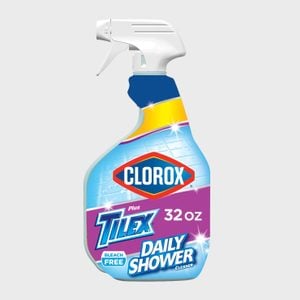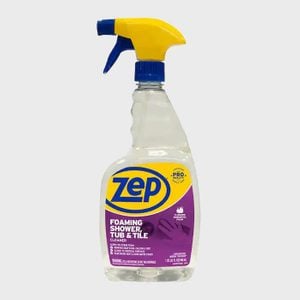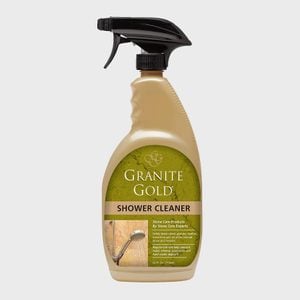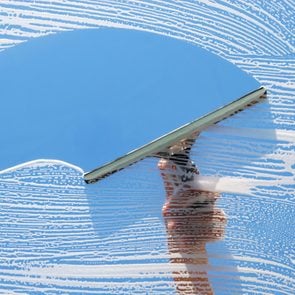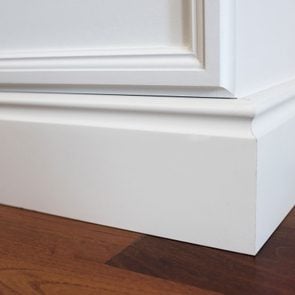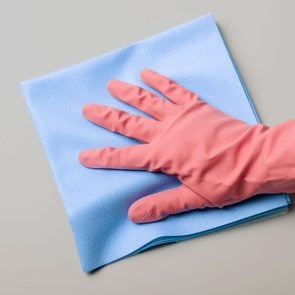How to Clean Every Type of Shower Quickly and Easily
Updated: Jun. 21, 2024

Think you know how to clean a shower? If you’re not following these tips for tile, stone and more, you might accidentally ruin yours.
Our editors and experts handpick every product we feature. We may earn a commission from your purchases.Learn more.
At the end of a long, hard day, there’s nothing more relaxing than a hot shower. But nothing ruins your spa-like experience faster than seeing soap scum, mildew or pink slime. The writing’s on the walls, literally: It’s time to clean the shower. But do you know how to clean a shower the right way?
You might think you do because it’s a regular part of your cleaning schedule, along with cleaning glass shower doors or a shower curtain, but this task isn’t quite as straightforward as cleaning the rest of your bathroom—it’s even different than cleaning your bathtub. “Before you start cleaning, you need to know exactly what your shower is made of,” says green cleaning expert Leslie Reichert. “The wrong product will do more harm than good.”
Ready to bring the sparkle back to your shower? Whether yours is made of ceramic, fiberglass or stone, here are the expert-approved tips to clean everything—and get the job done quickly and easily.
Get Reader’s Digest’s Read Up newsletter for more cleaning, humor, travel, tech and fun facts all week long.
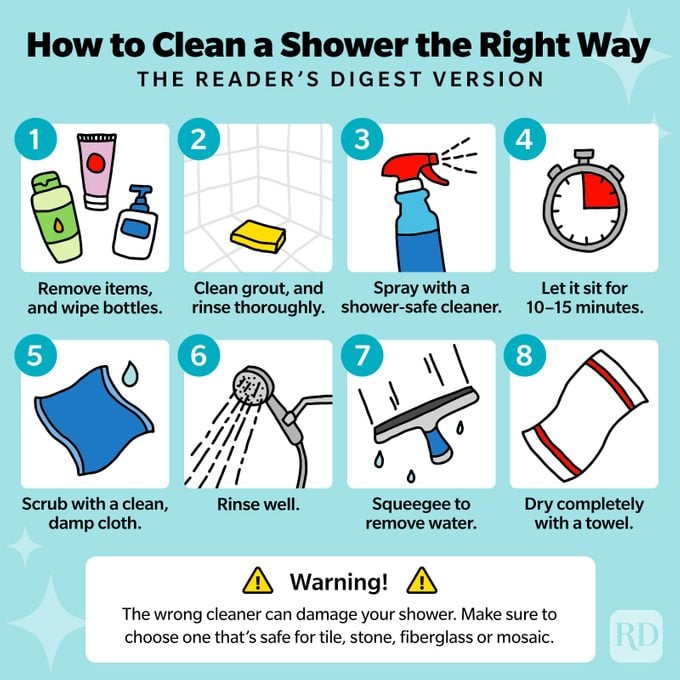
How often should you clean your shower?
Try to clean your shower once a week, says Reichert. To make the job easier, dry the shower after every use. Moisture is a breeding ground for mold, mildew and slime-creating bacteria, and you can greatly reduce these problems by squeegeeing the walls, floor and door of the shower, then drying everything with a towel.
To reduce humidity, leave the shower door or curtain open, turn on the bathroom fan or open a window for 10 to 15 minutes after the fog on the mirror clears. Skip this step, and you’ll soon see mildew, slime and soap scum—unwelcome reminders that it’s time to clean again. While we’re on the topic, make sure you know how to clean your mirror so there aren’t any streaks.
Does the type of shower affect how you clean it?
Short answer: yes. The most popular shower materials are acrylic/fiberglass, ceramic, glass and stone (think: marble, granite and other natural stone), and there are specific cleaning products and regimens for each. The vinegar that cleans fiberglass, for example, may etch the finish on marble. Ammonia may work on mosaic tile, but it can wreak havoc on fiberglass. And chlorine bleach is a no-no on stone, fiberglass and acrylic. For best results, use cleaners that are made specifically for your shower’s material. When in doubt, contact the manufacturer.
One caveat: Always wear protective gloves and goggles when handling strong chemicals like chlorine bleach, and turn on vent fans or open a window so air circulates. Also, never use bleach with cleaners that contain ammonia or vinegar. This mixture produces a toxic, odorless gas that can be deadly.
How to clean a tile shower
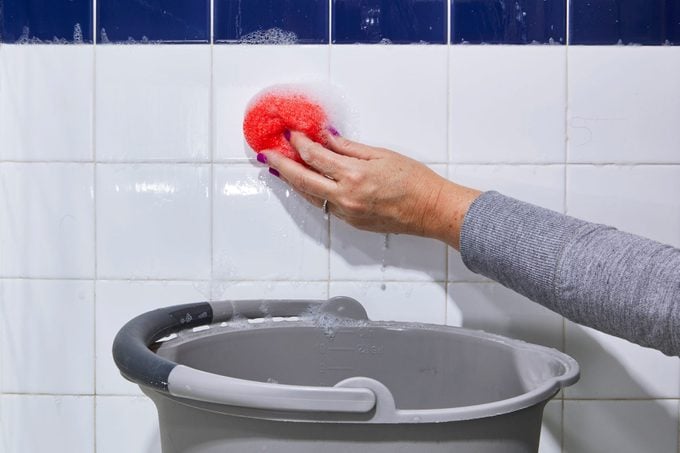
Ceramic and porcelain tiles have been go-to shower materials for years, and for good reason. They’re inexpensive, water- and stain-resistant, and not just easy to clean but also easy to keep clean.
Supplies:
- Clorox Plus Tilex Fresh Daily Shower Cleaner
- Microfiber cloth
- Plastic mesh scrubber or scrubbing sponge
- Tile and grout brush or toothbrush
- Squeegee
- Microfiber towel or old bath towel
Directions:
- Remove all items from the shower and wipe down bottles, especially the bottoms, with a damp microfiber cloth.
- Check out the grout before cleaning the tiles. Address any stains or mildew using a commercial grout cleaner or Reichert’s DIY version below.
- Rinse grout completely.
- Spray the tile cleaner on your shower, completely covering the tiles. Allow it to sit for 10 minutes.
- Scrub tiles with a clean, damp microfiber cloth or a Teflon scrubbing sponge for stubborn grime.
- Rinse well.
- Squeegee to remove excess water, and dry completely with a towel.
Pro tips: Skip cleaners that contain colored dyes, bleach, ammonia or abrasives, which could damage the surface and degrade the grout. Prefer a DIY cleaner? Simply mix equal parts distilled white vinegar and water.
How to clean a fiberglass shower
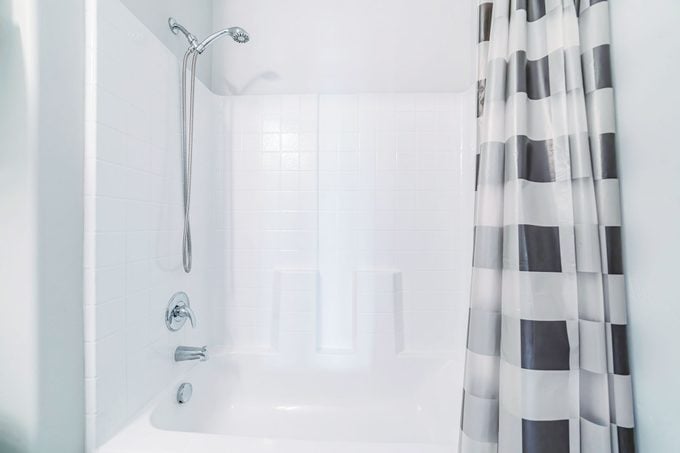
They may be low maintenance and resistant to cracking, mold and mildew, but fiberglass and acrylic showers still need some regular TLC. For daily upkeep, Reichert likes to dilute her weekly cleaning product. “I put an inch or so of EnviroRite Tub and Tile Cleaner in a 16-ounce spray bottle and fill the rest with water,” she says, noting that a diluted version of your weekly cleaner works just as well as commercial daily sprays. Just make sure to wipe off any spray that lands on faucets and fixtures.
Supplies:
- Zep Foaming Shower Tub and Tile
- EnviroRite Tub and Tile Cleaner
- Spray bottle
- Plastic mesh scrubber or scrubbing sponge
- Microfiber cloth
- Tile and grout brush or toothbrush
- Squeegee
- Microfiber towel or old bath towel
Directions for daily cleaning:
- After every use, squeegee the shower’s walls and floor, and dry with a towel. Or spritz a daily cleaning spray on the shower, from top to bottom.
- Wipe cleaner from faucets, as some may contain mild acid. No need to rinse it if you wipe it off completely.
- Open the shower door or curtain.
- Run a bathroom fan or open a bathroom window for 10 to 15 minutes after the fog on the mirror clears.
Directions for weekly cleaning:
- Remove all items from the shower, and wipe down bottles, especially the bottoms.
- Check out the grout before cleaning the tiles. Address any stains or mildew using a grout cleaner or Reichert’s DIY version below.
- Rinse grout completely.
- Spray the shower with cleaner. Allow it to sit for about 10 minutes.
- Scrub with a soft microfiber cloth or scrubby sponge.
- Rinse thoroughly with warm water.
- For stubborn stains, spray the shower with the cleaner once again, let it sit for 10 minutes, and then scrub with a 3M Sponge pad.
- Rinse well.
- Remove excess water with a squeegee, and dry completely with a towel.
Pro tips: Avoid products that contain ammonia, which can damage the surface, and gritty cleaners, which erode fiberglass’s gel coating and make it more vulnerable to soap scum and other gunk.
For a DIY approach, combine one part distilled white vinegar with three parts water. For excessive soap scum and grime, use two parts distilled white vinegar to one part water.
How to clean a stone shower
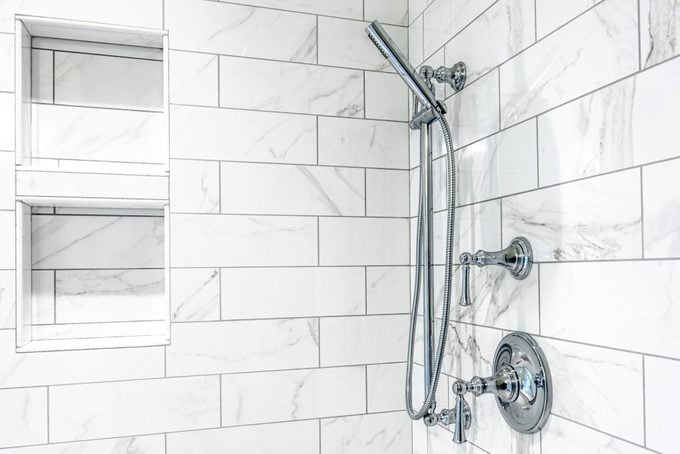
Stone showers—whether they are granite, marble or slate—are beautiful but slightly porous. If they’re not properly sealed, they can absorb minerals, which are plentiful in hard water and soap. To keep your stone shower in tip-top shape, apply a sealant such as Aqua Mix Sealer’s Choice Gold once a year or when water no longer beads on the tiles or the tiles appear darker when wet.
Supplies:
- Granite Gold Shower Cleaner
- Microfiber cloth
- Plastic mesh scrubber or scrubbing sponge
- Tile and grout brush or toothbrush
- Squeegee
- Microfiber towel or old bath towel
Directions:
- Remove all items from the shower, and wipe down bottles, especially the bottoms.
- Check out the grout before cleaning the tiles. Address any stains or mildew using a grout cleaner or Reichert’s DIY version below.
- Rinse grout completely.
- Spray cleaner onto tiles. Allow it to sit for 10 to 15 minutes.
- Scrub with a damp microfiber cloth.
- Rinse thoroughly.
- Squeegee, and dry from the top down to prevent streaking.
- Polish weekly with a microfiber towel. After drying the shower with a microfiber towel, use a fresh microfiber cloth and buff the tiles till they shine.
Pro tips: Steer clear of abrasive cleaners or products that contain dyes, bleach or acidic ingredients, like lemon or vinegar, as they can damage the finish. To make your own stone-safe cleaner, combine one quart of warm water with one teaspoon of a mild dishwashing detergent, like Clear Dawn. This information is also important if you’re cleaning stone countertops.
How to clean a glass or mosaic shower

Nonporous glass tiles are a cinch to clean, and they’re very resistant to staining, mold and mildew. But surfaces can scratch easily, so opt for mild cleaners and microfiber cloths.
Supplies:
- CLR Brilliant Bath Foaming Multi-Surface Cleaner or Rejuvenate Scrub Free Soap Scum Remover Shower Glass Door Cleaner
- Plastic mesh scrubber or scrubbing sponge
- Tile and grout brush or toothbrush
- Microfiber cloth
- Squeegee
- Microfiber towel or old bath towel
Directions:
- Remove all items from the shower, and wipe down bottles, especially the bottoms.
- Check out the grout before cleaning the tiles. Address any stains or mildew using a grout cleaner or Reichert’s DIY version below.
- Rinse grout completely.
- Spray with a glass tile cleaner. Let it sit for 10 minutes.
- Scrub lightly with a microfiber cloth to remove soap scum and other grime.
- Rinse well.
- Squeegee off excess water, and dry with a soft towel.
Pro tips: For a more natural cleaning solution, try a mixture of equal parts water and vinegar, or a solution of one teaspoon of Dawn detergent to one gallon of water.
Can you use vinegar to clean your shower?
Vinegar is a go-to when it comes to cleaning showers made of fiberglass or acrylic, glass and ceramic. It’s acidic enough to dissolve soap scum and grease, fight mold and mildew, and loosen mineral buildup caused by hard water. To use, simply spray the problem area with a solution of equal parts water and vinegar. Let it work for about 10 minutes, then wipe it off with a damp microfiber cloth or other soft cloth.
Have granite or marble showers? Skip the vinegar. It can damage the sealant and discolor or etch the stone.
Also keep in mind that there are two products you should never mix with vinegar: hydrogen peroxide and bleach. When mixed with hydrogen peroxide, it produces peracetic acid. When mixed with bleach, it produces toxic chlorine gas. Both can also cause respiratory issues and irritate eyes and skin.
What’s the best way to clean grout?
Reichert recommends cleaning the stained areas of grout before cleaning the tile. Her preferred cleaner is a DIY mixture: a half cup of baking soda (for scrubbing), one tablespoon of Dawn dish detergent (for removing oils) and enough hydrogen peroxide to make a paste (for bleaching). Apply the mixture to the stained area, and let it sit for 10 minutes. Wipe with a scrubbing sponge, toothbrush or grout brush, rinse well, squeegee excess water and dry completely with a towel. For more details and other options, check out our comprehensive guide to how to clean grout.
What’s the best way to clean a showerhead?
When water flowing from your shower goes from sizzle to drizzle, it may be time to clean the shower head thoroughly. As a wise preventive maintenance policy, clean it at least once a month. This will involve removing mineral buildup, unclogging the individual nozzles and cleaning the filter to restore the flow.
What’s the best way to get rid of mold?
When you first notice the telltale black dots on grout lines or patches of black on shower tiles, try to remove them with a soft scrub brush or a toothbrush and plain water. If they come off easily, great!
If brushing doesn’t do the trick, mix baking soda and hydrogen peroxide to form a paste. Spread it on the mold, and allow it to sit for a few minutes. Then scrub gently with a soft scrub brush or a toothbrush, rinse well and dry completely.
If the mold stain persists, try spraying the stain with hydrogen peroxide and a few drops of tea tree oil, an antifungal. Allow the solution to work for several minutes, then scrub with a soft brush or toothbrush, rinse well and dry completely. For stubborn stains, repeat until the stain is gone.
You can also use a commercial mold killer such as CLR Clear Mold and Mildew Remover. It is safe for ceramic tile, glass tile and fiberglass. For granite and marble, try Stone Care International Granite and Stone Stain Remover.
Stain still not budging? Unfortunately, the color may be there for good. At this point, Reichert recommends replacing the caulking and grout.
What’s the best way to get rid of soap scum and stains?
A big part of knowing how to clean a shower is learning how to tackle soap scum. This white or gray film is produced when minerals in hard water combine with soap. Gross, we know. But the good news is that it can be removed with commercial products or a DIY mixture. The key is to attack it at least weekly so it doesn’t build up. Your regular cleaner should do the trick, but if you don’t regularly clean your shower every week, you may have to do some catching up to remove the soap scum that has built up over time.
For glass, ceramic, fiberglass/acrylic and stone, try Rejuvenate Soap Scum Remover. Spray it on, let it sit, then rinse. Rejuvenate recommends trying it first on an inconspicuous spot to make sure you’re happy with the results.
Prefer green cleaning? Reichert suggests mixing one cup of vinegar, one cup of water and a tablespoon of dish detergent in a spray bottle. Spray onto surfaces, and allow it to work its magic for 10 minutes. Then wipe surfaces with a clean sponge or microfiber cloth. Rinse well, squeegee away excess water and dry completely.
To remove soap scum on glass shower doors, Reichert uses Mr. Clean Magic Eraser. “It is fabulous on glass doors and takes off water spots and soap scum—and no scratching,” she says.
Pink slime, another scum found in showers and bathtubs, is actually a bacteria that thrives on minerals (like those in hard water) and fats (like those in shampoo). If you spot it in your shower, don’t panic. It’s fairly easy to remove—here’s how.
What’s the best way to get rid of tough stains?
Hard water stains and limescale in showers can be tackled by spraying vinegar directly onto the stain and sprinkling it with baking soda. Allow this to work for about 10 to 15 minutes, then rub it off with a microfiber cloth or scrubby sponge. Rinse well, squeegee and dry completely.
To remove these stains from faucets, Reichert suggests cutting a lemon in half, soaking a cloth with the juice from half the lemon and wrapping it around the stained part. To clean the faucet head, she simply presses the second half of the lemon into the faucet, fastens it with a rubber band, and allows it to sit for at least 15 minutes—or even overnight. Lemon is safe for all faucet materials, so it is a good choice for fixtures.
Another idea: Mix equal parts vinegar and water, spray it on the stain and let it work for 15 minutes. For shower doors, apply two coats a few minutes apart since the cleaner runs down the door. Gently scrub, and wipe away stains and scale.
The best shower cleaners
Pro tips to keep your shower clean
And now you’re an expert on shower cleaning! Well, almost. First, you have to remember these tips and tricks that the pros swear by.
- After every shower, squeegee away excess water and wipe down your shower walls, door and floor with a dry towel.
- To further reduce humidity after a shower, run the vent fan for 10 to 15 minutes after the mirror is no longer foggy.
- Give your shower cleaner a chance to work. Don’t spray and then swipe immediately. For best results, it should sit for 10 to 15 minutes before you start scrubbing.
- To reduce buildup, use a daily cleaner. Just spray it and walk away. You don’t have to rinse it!
- If you’re tired of dealing with soap scum, switch from bar soap to a liquid body wash.
- Seal grout every few months to keep it in tip-top shape.
Now that you know how to clean a shower, learn how to clean every type of floor quickly and easily.
Source:
- Leslie Reichert, green cleaning expert and author of The Joy of Green Cleaning





















